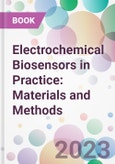A biosensor is an integrated receptor-transducer device that converts a biological response into an electrical signal. The design and development of biosensors have taken center stage for researchers or scientists in the recent decade owing to the wide range of biosensor applications in healthcare and disease diagnosis, environmental monitoring, water and food quality, and drug delivery. Due to their adaptability, ease of use in relatively complex samples, and portability, the significance of electrochemical biosensors in analytical chemistry has increased manifold. Electrochemistry has been pivotal in developing transduction methods for biological processes and biosensors. In parallel, the explosion of activity in nanoscience and nanotechnology and their huge success have profoundly affected biosensor technology, opening new avenues of research for electrode materials and transduction.
Electrochemical Biosensors in Practice: Material and Methods particularly explores the use of silver and gold nanoparticles for signal amplification, photocurrent transduction, and aptamer design. Therefore, the book serves as an introductory text for those specializing in biosensors and bioelectronics and their practical applications.
Key features
- Includes structured information for easy understanding of the subject
- Provides an introduction to biosensors and electrochemical biosensor classification
- Explains fundamental concepts and practical electrochemistry techniques for research
- Provides notes on essential electrochemical sensor materials such as graphene, carbon nanotubes, conductive polymers, and other advanced materials
- Provides information about electrochemical biosensor development
- Informs readers about recent applications and research findings
- Includes references for further reading
Table of Contents
Chapter 1 Introduction to Electrochemical Biosensors
- Introduction
- Basic Principle of Biosensor
- Classification of Biosensors Based on Transducers
- Electrochemical Biosensors
- Optical Biosensors
- Mass-Base Biosensors
- Thermal Biosensors
- Energy Biosensors
- Classification of Biosensors Based on Bioreceptor
- Enzyme
- Antibody
- Aptamers
- Cells
- Microbial
- Electrochemical Biosensors
- Fundamentals and Terminology
- Voltammetric Biosensors
- Potentiometric Biosensors
- Impedimetric Biosensors
- Economic and Market for Biosensors
- The Biomedical Sector
- The Food Production Industry
- Protection of the Environment
- Markets and Application Fields
- Conclusion
- References
Chapter 2 Electrochemical Biosensors Design Steps
- Introduction
- Electrochemical Biosensors Design Steps
- Step 1: Desired Analyte Selection
- Step 2: Biosensing Mode Determination
- Step 3: Working Electrode and Cell Elements Selection
- Step 4: Material Platform Design
- Step 5: Biological Element Determination
- Step 6: Immobilization Method Design
- Step 7: Post Processing
- Step 8: Doe of Previous Steps
- Step 9: Biosensor Functional Characterization
- Step 10: Data Analysis and Reporting
- Biosensing Mode Determination
- Detection or Measurement Mode Based on Process
- Detection or Measurement Mode Based on Electrochemical Transduction
- Biological Element Determination
- Immobilization Method Design
- Methods of Irreversible Immobilization
- Methods of Reversible Immobilization
- Post Processing
- Inner and Outer Membranes
- Biocompatible and Biostable Surfaces
- Biosensor Functional Characterization and Reporting
- Calibration Characteristics
- Selectivity
- Reliability
- Steady-State and Transient Response Times
- Sample Throughput and Recovery Time
- Reproducibility
- Stability
- Lifetime
- Conclusion
- References
Chapter 3 Material and Biomaterial for Biosensing Platform
- Introduction
- Carbone-Based Materials
- Fullerenes
- Carbone Nanotube
- Graphene
- Nanodiamonds of Carbon
- Carbon Nanohorns
- Carbon Dots
- Carbon Nanofibers
- Polymers and Conductive Polymers
- Identification Element Immobilization Techniques
- Assortments of Mnppf for Electrochemical Biosensors and Transducers
- Provision of Molecular Imprinted Polymers/Surface Imprinted Polymers for Electrochemical Biosensor
- Dendrimers
- Electrochemical Biosensing Based on Mnppfs
- Nanoparticles
- Gold Nanoparticles
- Platinum Nanoparticles
- Silver Nanoparticles
- Palladium Nanoparticles
- Nickel Nanoparticles
- Copper Nanoparticles
- Iron(Iii) Oxide Nanoparticles
- Titanium Dioxide Nanoparticles
- Zinc Oxide Nanoparticles
- Zeolites and Other Aluminosilicates With Nanoscale Structure
- Inorganic Quantum Dots
- Doped Inorganic Nms
- Nanostructured Carbon Black
- Calixarenes
- Biological Elements and Biomaterials
- Enzymatic Nanocomposites
- Nucleic Acid Nanocomposites
- Immunoassay Based Nanocomposites
- Aptasensor
- Biopolymeric Nanocomposites
- Composite and Sandwich Platforms
- Sandwich Platform
- Composite
- Conclusion
- References
- Chapter 4 Basic Practical Principles for Studying Electro- Chemical Biosensors -Introduction
- Design of Experiments
- Fundamentals
- Approaches to Design of Experiments
- Components of Experimental Design
- Purpose of Experimentation
- Guidelines for Designing Experiments
- Experiment Design Process
- Instrumentation
- Electrochemical Cell
- Working Electrode
- Reference Electrode
- Counter Electrode
- Other Electrochemical Cells
- Principles of Potentiostats
- Experiments With Two, Three, and Four Electrodes
- Electrochemical Techniques
- Amperometric
- Potentiometric
- Impedometric
- Working With Biological Elements
- What is Cell Culture?
- Cell Culture Conditions
- Morphology of Cells in Culture
- What is Subculture?
- Applications of Cell Culture
- Biologically Important Molecules
- Conclusion
- References
Chapter 5 Biosensor Application
- Introduction
- Medical Diagnosis
- Genetic Disorder
- Dna Fragmentation
- Detection of Pathogenic Microbes
- Autoimmune-Mediated Inflammatory Disease
- Chronic Autoimmune Disease
- Application for Diagnostics
- Pathogen Diagnostics
- Tumor Markers
- Cardiac Marker
- Analyses of Drug Action
- Other Works
- Environmental Monitoring
- Heavy Metal
- Pesticides
- Food Quality
- Food Toxins
- Antibiotic Residues
- Study of Enzyme Kinetics
- Conclusion
- References
- Subject Index
Author
- Seyed Morteza Naghib
-Seyed Mahdi Katebi
-Sadegh Ghorbanzade








